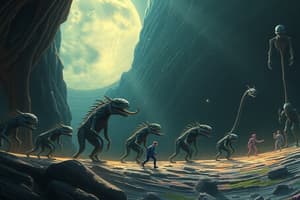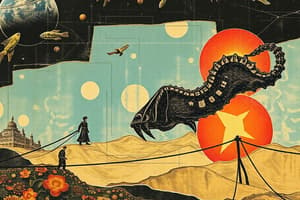Podcast
Questions and Answers
What defines sexual reproduction?
What defines sexual reproduction?
- Production of offspring through binary fission
- Reproduction involving one parent
- Reproduction of two parents creating a genetically unique organism (correct)
- Development of offspring from unfertilized eggs
Which of the following is NOT a type of asexual reproduction?
Which of the following is NOT a type of asexual reproduction?
- Budding
- Viviparous reproduction (correct)
- Fragmentation
- Binary Fission
What is the first step in the genetic engineering technique?
What is the first step in the genetic engineering technique?
- Remove the gene from the rest of the DNA using a restriction enzyme
- Extract the entire DNA from the organism
- Insert the new gene into an existing organism's DNA
- Identify an organism that contains a desirable gene (correct)
Which characteristic differentiates endotherms from ectotherms?
Which characteristic differentiates endotherms from ectotherms?
What is the primary function of the anther in a flower?
What is the primary function of the anther in a flower?
Which of the following structures is considered vestigial?
Which of the following structures is considered vestigial?
Which term refers to the transfer of pollen to the female part of the flower?
Which term refers to the transfer of pollen to the female part of the flower?
What does negative feedback in biological systems aim to achieve?
What does negative feedback in biological systems aim to achieve?
What distinguishes an organism from a population?
What distinguishes an organism from a population?
Which of the following is a key component of osmoregulation?
Which of the following is a key component of osmoregulation?
Which term describes the sticky part that catches pollen in a flower?
Which term describes the sticky part that catches pollen in a flower?
All of the following can contribute to extinction except:
All of the following can contribute to extinction except:
What is the significance of double fertilization in angiosperms?
What is the significance of double fertilization in angiosperms?
Which component of the flower is considered the female reproductive part?
Which component of the flower is considered the female reproductive part?
What process results in the growth of seedlings into plants?
What process results in the growth of seedlings into plants?
How do gymnosperms differ from angiosperms?
How do gymnosperms differ from angiosperms?
Which scientist is known for proving that organisms do not arise spontaneously?
Which scientist is known for proving that organisms do not arise spontaneously?
What type of formations are stromatolites primarily associated with?
What type of formations are stromatolites primarily associated with?
Which theory suggests that life was present in the form of spores from another planet?
Which theory suggests that life was present in the form of spores from another planet?
Which of the following is attributed to Louis Pasteur?
Which of the following is attributed to Louis Pasteur?
What essential material did Aristotle believe was necessary for life to arise from non-living materials?
What essential material did Aristotle believe was necessary for life to arise from non-living materials?
Which of the following statements about cells is correct?
Which of the following statements about cells is correct?
Who was the first to discover and describe microorganisms, which he called 'Animalcule'?
Who was the first to discover and describe microorganisms, which he called 'Animalcule'?
Which theory proposes that life began in deep-sea hydrothermal vents?
Which theory proposes that life began in deep-sea hydrothermal vents?
Flashcards
Paleontologist
Paleontologist
A scientist who studies ancient life forms by collecting and analyzing fossils.
Fossil
Fossil
Preserved remains or traces of ancient organisms.
Theory of Biogenesis
Theory of Biogenesis
The scientific idea that all living things come from pre-existing living things.
Cells
Cells
Signup and view all the flashcards
Spontaneous Generation
Spontaneous Generation
Signup and view all the flashcards
Cytology
Cytology
Signup and view all the flashcards
Cell Theory
Cell Theory
Signup and view all the flashcards
Atom
Atom
Signup and view all the flashcards
Sexual Reproduction
Sexual Reproduction
Signup and view all the flashcards
Binary Fission
Binary Fission
Signup and view all the flashcards
Genetic Engineering
Genetic Engineering
Signup and view all the flashcards
Endotherm
Endotherm
Signup and view all the flashcards
Ectotherm
Ectotherm
Signup and view all the flashcards
Negative Feedback
Negative Feedback
Signup and view all the flashcards
Evolution
Evolution
Signup and view all the flashcards
Homologous Structures
Homologous Structures
Signup and view all the flashcards
Organism
Organism
Signup and view all the flashcards
Tissue
Tissue
Signup and view all the flashcards
Organ System
Organ System
Signup and view all the flashcards
Gamete
Gamete
Signup and view all the flashcards
Zygote
Zygote
Signup and view all the flashcards
Pollination
Pollination
Signup and view all the flashcards
Self-pollination
Self-pollination
Signup and view all the flashcards
Angiosperm
Angiosperm
Signup and view all the flashcards
Study Notes
Lesson 1: Early Life and its Theories
- Paleontologists: Scientists who study early life forms
- Fossil: Preserved remains of ancient organisms
- Stromatolites: Layered formations created by photosynthetic cyanobacteria
- Deep Sea Vent Theory: Early life originated from hydrothermal vents in the ocean
- Theory of Special Creation: Life created by supernatural powers
- Theory of Panspermia (Spore Theory): Life arrived on Earth from another planet in resistant spores
- Primordial Soup Theory: Life originated from water with lightning
- Theory of Spontaneous Generation (Abiogenesis): Nonliving materials spontaneously create life
- Pneuma: Material needed for life to arise from non-living
- Francisco Redi: Experiments disproving spontaneous generation of organisms
- John Needham: Experiment attempting to prove spontaneous generation, flawed experiment
- Louis Pasteur: Experiments demonstrated that spontaneous generation does not occur
- Theory of Biogenesis: Life arises only from pre-existing life
- Alexander Oparin: Hypothesized primitive Earth's atmosphere contained gases like ammonia, methane, hydrogen, and water vapor
- Cytology: Study of cells
- Cells: Smallest unit of life
- Zacharias Janssen: Inventor of the microscope
- The Cellular Basis of Life (Robert Hooke): Observed tiny compartments in cork and named them "cells."
Lesson 2: Biological Systems
- Biological System: Complex system of interacting parts forming an organization
- High Degree of Organization: Hierarchy of biological structures and systems
- Atom: Basic unit of matter
- Molecule: Group of two or more atoms
- Cell: Basic unit of life
- Tissue: Group of similar cells
- Organ: Structure composed of multiple tissues
- Organ System: Group of organs working together
- Organism: Individual living entity
- Population: Group of same species
- Community: All populations interacting
- Ecosystem: All living and non-living things interacting
- Biosphere: All ecosystems on Earth
- Form and Function: Structure directly relates to function
- Reproduction and Inheritance: Organisms reproduce and pass traits to offspring
- Interaction with the Environment: Biotic (living) and abiotic (non-living) interact
- Energy: Requirement to maintain biological functions
- Regulation/Homeostasis: Ability to adjust to the environment
- Evolution and Diversity: Explains the diversity of life and adaptation
- Scientific Inquiry: Method to gain knowledge
Lesson 3: Plant Reproduction
- Stamen: Male reproductive part
- Filament: Supports the anther
- Anther: Produces pollen
- Pollen: Male gametes (containing genetic material)
- Carpel/Pistil: Female reproductive part
- Stigma: Catches pollen
- Style: Connects stigma to ovary
- Ovary: Contains ovules
- Ovule: Contains female gametes
- Gametes: Reproductive cells
- Zygote: Formed by fusion of gametes
- Fertilization: Fusion of gametes
- Pollination: Transfer of pollen to the female part
- Self-Pollination: Pollen transfer on the same plant.
- Cross-pollination: Pollen transfer to another plant.
- Angiosperms: Flowering plants
Lesson 4: Genetic Engineering
- Genetic Engineering: Direct DNA manipulation to alter characteristics
- Genetically Modified Organism (GMO): Organism with altered genetic material
- Genetic Modification Techniques: Identified desirable gene, extracting DNA, removing the desired gene, insert new gene
- GMA: Genetically modified animals
- GMP: Genetically modified plants
- GMO: Genetically modified organisms
Lesson 5: Respiration
- Respiration: Gas exchange in organisms
Lesson 6: Evolution and Environmental Changes
- Evolution: Gradual change and development of species
- Embryology: Scientific study of embryos
- Homologous Structures: Similar physical structures with the same evolutionary origin
- Vestigial Structure: Feature inherited but no longer necessary
- Genetics: Study of heredity
- Environmental Changes: Factors affecting extinction (atmosphere, temperature, floods, radiation, impacts, diseases, etc.)
- Balance of Nature: Ecosystems can support only a certain number of individuals
- Diversity and Stability: Organisms have specific roles in ecosystems
- Resistance/Resilience: Ability to remain stable/adapt to changes
- Endotherm: Warm-blooded animals can regulate body temperature
- Ectotherm: Cold-blooded animals body temperature matches surroundings
- Negative Feedback: Reduces an excessive response
- Positive Feedback: Intensifies a response
- Excretion: Removal of wastes from the body
- Osmoregulation: Maintaining the balance of salt and water
Lesson X: Ecosystems
- Terrestrial Ecosystem: Land-based ecosystem
- Aquatic Ecosystem: Water-based ecosystem
- Grassland: Ecosystems dominated by grasses
- Desert: Regions with minimal rainfall
- Marine Ecosystem: Largest ecosystem, high dissolved salts
- Freshwater: Minimal salt, 0.8% of Earth's surface
- Human Activities: Damaging impact on ecosystems
Studying That Suits You
Use AI to generate personalized quizzes and flashcards to suit your learning preferences.




